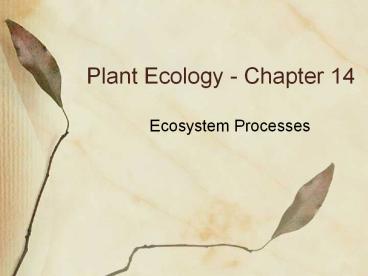Plant Ecology - Chapter 14 PowerPoint PPT Presentation
Title: Plant Ecology - Chapter 14
1
Plant Ecology - Chapter 14
- Ecosystem Processes
2
Ecosystem Ecology
- Focus on what regulates pools (quantities stored)
and fluxes (flows) of materials and energy in
abiotic and biotic components
3
Ecosystem Ecology
- Turnover time - how rapidly does it move through
the system - Retention time - how long does it reside in a
component
4
Ecosystem Ecology
- Pools, fluxes connected together into
biogeochemical cycles - Biology, geology, chemistry interconnected
5
Ecosystem Ecology
- Plants under the influence of some cycles,
influence others - Water, oxygen, carbon, nitrogen, phosphorus,
sulfur, potassium
6
Water Cycle
7
Water Cycle
- Terrestrial plants are only living things to have
significant effect on water cycle - Evapotranspiration from plants can provide huge
proportion of moisture in atmosphere - affect
rainfall patterns
8
Water Cycle
- Cutting rainforests can result in decreased
evapotranspiration, decreased rainfall, increased
air temperatures at ground surface
9
Water Cycle
- Since plants intercept rainfall, reduce its
impact on ground, removing vegetation can alter
infiltration/runoff relations
10
Water Cycle
- Even removing vegetation in semi-arid regions can
reduce rainfall, increase soil temperatures,
induce onset of desertification
11
Water Cycle
Flux differences among, within biomes
12
Water Cycle
- Potential evapotranspiration (PET) - water lost
via this process if water is freely available and
plant cover is 100 - Actual evapotranspiration (AET) - precipitation
minus runoff and infiltration - PETgtAET in dry climates
- PETAET in intact tropical rain forests
- AET linked to productivity, decomposition
13
Carbon Cycle
Primary productivity - rate of transfer of
inorganic C from atmosphere into organic C in
plants via photosynthesis
14
Carbon Cycle
NPP - dry metric tons/ha/yr
15
Productivity
Different forests - latitude, climate, elevation
Different ecosystems - related to leaf biomass
16
Productivity
17
Estimating Productivity
- Standing biomass after a growing season
- Drawbacks destructive, and ignores belowground
productivity (can be majority in some plants)
18
Estimating Productivity
- Indirect measures develop formulae for relating
plant size changes to biomass changes - Allometric relationships used by timber
companies, forest ecologists - Drawback formula needed for each species
19
Estimating Productivity
- Indirect measures use relation between
productivity and AET - Fairly good estimates of productivity over broad
range of climates - Drawback poor predictor of productivity where
precipitation and temperature are both high
20
Estimating Productivity
- Remote sensing - use reflectance of light
wavelengths by chlorophyll to estimate
productivity - Normalized difference vegetation index (NDVI) -
good correlation between NDVI and NPP ground
measurements
NDVI NIR-VIS NIRVIS
21
Decomposition
Dead stuff becomes soil organic matter, then
via mineralization becomes inorganic nutrients,
CO2, water, and energy
22
Decomposition
- Saprophytic fungi are the major decomposers of
dead leaves, plant litter - Bacteria also
essential, but only in latter stages
23
Decomposition
Root decomposition of soft and hardwoods
- Decomposition largely an aerobic process - very
slow in waterlogged, cold soils - Physical, chemical characteristics also affect
rate of decomposition
24
Net Ecosystem Production
- NEP is net accumulation of carbon per year by
ecosystem - Positive during growing season, negative during
non-growing season
25
Net Ecosystem Production
- Undisturbed ecosystems usually show small,
positive accumulations of C each year - Accumulation of woody tissue in long-lived plants
26
Soil Carbon Pools and Fluxes
27
Nitrogen Productivity
28
Nitrogen Cycle
- Rapid flux through living organisms
- Large global pool with slow turnover
29
Phosphorus Cycle
- Does not have major atmospheric
- pool like other cycles
- Mostly recycled in organic form
- through other living organisms
30
Calcium Cycle
- Sedimentary cycle
- Needed by plants for chemical (growth, stress
regulation), structural (support) roles - Largely lost in leaf fall - must be replaced each
year
31
Calcium Cycle
- Calcium depletion occurring in many forests today
- Acid deposition displaces soil calcium, logging
removes it - Decreased growth, higher mortality (more
susceptible to pathogens)

